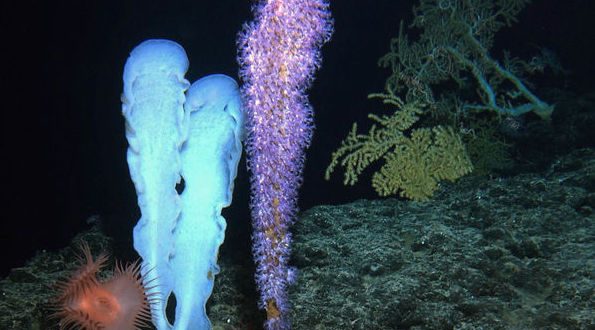Scientists have made the first expedition to Cook seamount, a 13,000-foot (3960m) extinct volcano at the bottom of the Pacific Ocean off the coast of Hawaii’s Big Island.
The scientists spotted a rare kind of octopus with big fins that look like an elephant’s ears and a possibly new type of violet-colored coral they dubbed Purple Haze.
Conservation International, which was part of the expedition, said it wants to study 50 seamounts, over the next five years.
“We don’t know anything about the ocean floor,” Peter Seligmann, co-founder of Conservation International, told the Associated Press. “What we know is that each one of those seamounts is a refuge for new species, but we don’t know what they are. We don’t know how they’ve evolved. We don’t know what lessons they have for us.”
Seamounts can be active or dormant volcanoes that rise drastically from the ocean floor and never get to the surface. Because they move nutrient-rich water up from the sea floor, they are hotspots for aquatic life. Seamounts are thought to cover approximately 18 million square miles of ocean floor.
Cook, positioned over 100 miles southwest of Hawaii’s Big Island, belongs to a gaggle of undersea volcanoes referred to as the Geologist Seamounts that are around 80 million years old and may hold many new animal species, as well as valuable elements like nickel and cobalt.
Within a few minutes of the vessel’s appearance at the summit, life started to appear. Observers saw a starfish clinging to a stone, followed by eels, sharks, shrimp, crabs and two rare Dumbo octopuses. Quite a number of deep-sea corals were discovered along the seamount’s cliffs, including a radiant purple variety.
Two other seamounts were examined over three-day research trip: McCall and Lo’ihi, an active volcano.
Lo’Ihi has been thoroughly surveyed by manned submersibles over the last three decades. As volcanic gases from Lo’Ihi swirled around them, the team launched bait in the water and a 7-foot shark appeared in front of the submarine.
The team also saw 6-foot eels and several new geological formations around the crater. Researchers said Lo’ihi is probably to someday become the newest island in the Hawaii chain as volcanic activity shoves the summit upward.
Agencies/Canadajournal
 Canada Journal – News of the World Articles and videos to bring you the biggest Canadian news stories from across the country every day
Canada Journal – News of the World Articles and videos to bring you the biggest Canadian news stories from across the country every day



